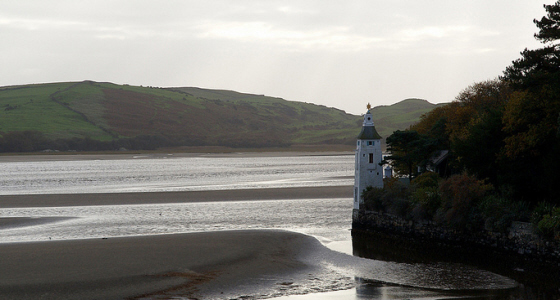
© Words - Simon Wells
You might well ask this of yourself as you wander around an otherwise uneventful piece of North Wales coastline. At this point though, it would probably be wise to suspend reality for a while. Tucked into the corner of a secluded cove lies the mysterious and enigmatic village of Portmeirion. To the cynical, the very notion of the place might seem a trifle incongruous. An Italianate village situated within the austere Welsh mountain ranges certainly seems to be an audacious proposition, and yet Portmeirion has continued to defy suspicion and controversy in its eighty-year tenancy. Dramatic and delicate, bold and intricate, Portmeirion’s kaleidoscopic mixture of styles and colours beautifully complement each other. The village's global celebrity has inspired thousands of pilgrims to sample its unique mixture of eclectic architecture and spiritual ambience. Quite simply, there is nowhere else on earth like it; a remarkable achievement and a testament of how one man’s dream became a reality.
The idea of Portmeirion had been germinating within architect Clough Williams-Ellis’ fertile mind since a child. As a young architect in the early 1920’s, his campaigns against the cavalier intrusions into the British countryside had garnered him a reputation as something of an environmental crusader. A founder of the Council for the Protection of Rural England, Clough trod lightly upon the earth, demanding an almost holistic approach to construction, insisting that any building should complement, and ultimately enhance its natural environment. Even before Portmeirion, Clough had become quite celebrated in architectural circles for the revolutionary methods he applied to numerous constructions around the United Kingdom. However, the desire to create his own personal nirvana burned deep within him. In an attempt to find the perfect location to host his vision, he’d taken to the seas, navigating his way around the coastlines of Britain, Europe, and even Australia, but with little success. Remarkable as it might seem, he would discover the ideal setting for his village some six miles from his ancestral doorstep in North Wales.
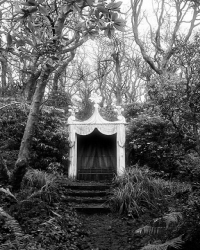 Prior to Portmeirion, an eccentric old lady inhabited the rambling 70-acre site, living in an old quayside manor house with her numerous pets. Such was her hermitic status, she’d let the grounds of the estate to become wildly overgrown. Following her death, the property, then known as Aber La, was put up for sale and brought to the attention of Clough Williams-Ellis. As the errant architect wandered around the neglected wilderness of tangled branches and abandoned workman’s cottages, he knew instinctively that this was the perfect spot for his dream hamlet to develop. Indeed, his innate artistry easily detected the natural amphitheatre that gently rolled down towards the sea. Given that the landscape was set on numerous levels, there was clearly enormous scope to construct something totally in line with his vision.
Prior to Portmeirion, an eccentric old lady inhabited the rambling 70-acre site, living in an old quayside manor house with her numerous pets. Such was her hermitic status, she’d let the grounds of the estate to become wildly overgrown. Following her death, the property, then known as Aber La, was put up for sale and brought to the attention of Clough Williams-Ellis. As the errant architect wandered around the neglected wilderness of tangled branches and abandoned workman’s cottages, he knew instinctively that this was the perfect spot for his dream hamlet to develop. Indeed, his innate artistry easily detected the natural amphitheatre that gently rolled down towards the sea. Given that the landscape was set on numerous levels, there was clearly enormous scope to construct something totally in line with his vision. “Directly I got inside the perimeter wall I knew I need look no further,” Clough would later recall on his first sortie. “This was perfection for what I wanted to do. So I resolved that here was my chance.”
Purchasing the estate in 1925 for £ 5,000, Clough poured his time and finances into what would ultimately be called Portmeirion (christened in part due to the creator’s love of the Italian coastal idyll, Portofino). Inspired, but not entirely consumed by the Mediterranean theme, Clough expanded the concept beyond the Neapolitan hues and livery to draw in other styles and ideas. Although a dreamer at heart, Clough was more than aware of the huge cost of the construction required, and realised early on that the village had to be self-financing to exist. To bank-roll future building work, the old lady’s manor house was converted into a prestigious hotel. Within time, numerous cottages and apartments would be incorporated into Portmeirion’s expanding roster of idiosyncratic accommodation. To increase the village’s income further, a nominal entrance fee was levied on the curious day-tripper.
Always in pursuit of the unusual and bizarre, Clough would regularly attend house auctions and sales, picking up discarded artefacts to incorporate directly into his village. Other pieces would come purely by chance. A large plaster Buddha, a leftover prop from the Welsh location shooting of “The Inn of Six Happiness”, was chanced upon by Clough and placed in its own mini-temple. A condemned stone bandstand from Bristol would be transported piece by piece and re-erected in a prominent position. Other bits and bobs from derelict baronial halls and manor houses would also be incorporated directly into the village. This magpie approach would lead Clough to jokingly christen Portmeirion as “a home to fallen buildings.”
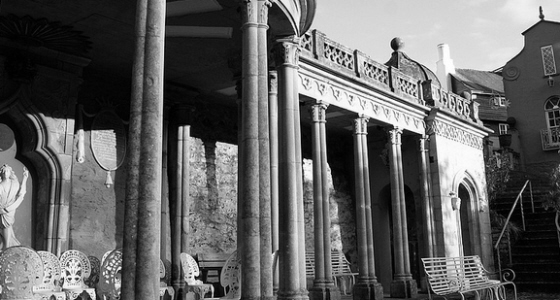
Clough’s enchanting village would soon build up a reputation as a secreted location for those seeking solitude from the intrusions of the outside world. As such, an exclusive guest list was established. Edward VIII and Wallis Simpson would occasional stow away in the hotel, while the likes of George Bernard Shaw, Aldous Huxley, and H.G Wells would recharge their creative batteries in the village’s gentle bonhomie. On a brief visit to Portmeirion in 1941, Noel Coward would pen his classic farce “Blithe Spirit”, in one of the village cottages. During the 1960’s, Beatles’ manager Brian Epstein was so enchanted with Portmeirion that he paid for several permanent alternations to his favourite apartment.
Actor Patrick McGoohan was one such creative artisan drawn by Portmeirion’s unique ambience. He had first utilised the village for a passable Italy for an episode of the 1960’s TV show Danger Man, and had been struck by its extraordinary enigma. In 1966 McGoohan, then Britain’s highest paid TV star, incorporated the location for his classic cult series “The Prisoner”; the Kafkaesque tale of a secret agent imprisoned in a remote village for resigning from a secret agent post. “I thought it was a miraculous sort of place-beautiful,” McGoohan would comment later on his first visit to Portmeirion. “I was astonished that I’d never seen this in a film. Already in my head this (was) a setting which could be beautiful enough, mysterious enough, and confining enough to be the base for our man in isolation.”
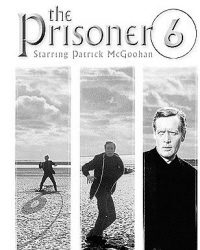 The exposure of “The Prisoner” opened Portmeirion up to the masses, becoming a huge attraction within North Wales. To this day, Prisoner fans and societies occasionally take over the gardens to re-enact key scenes from the programme, but despite the series being the high point of McGoohan’s career, the actor never returned to the village once filming ceased in 1967. These days, Portmeirion’s guardians take a couple of respectful paces back from “The Prisoner” connection; knowing that it is just one facet of the village’s extraordinary appeal. Nonetheless, the popularity of “The Prisoner” remains a magnetic draw, and has put a fair few pounds on Portmeirion’s annual taking on the gate.
The exposure of “The Prisoner” opened Portmeirion up to the masses, becoming a huge attraction within North Wales. To this day, Prisoner fans and societies occasionally take over the gardens to re-enact key scenes from the programme, but despite the series being the high point of McGoohan’s career, the actor never returned to the village once filming ceased in 1967. These days, Portmeirion’s guardians take a couple of respectful paces back from “The Prisoner” connection; knowing that it is just one facet of the village’s extraordinary appeal. Nonetheless, the popularity of “The Prisoner” remains a magnetic draw, and has put a fair few pounds on Portmeirion’s annual taking on the gate.By 1973, and after nearly fifty years of gradual building, Clough was finally able sit back and declare that Portmeirion was complete. He’d been rewarded with a knighthood for his services to architecture, and had the comforting reassurance that his creation had finally gained listed building status. Prior to his death in 1977, Sir Clough was often to be seen wandering around the village in his trademark plus-fours and deerstalker, greeting visitors and picking up the odd pieces of litter that some of the more unenlightened guests had discarded. Clough would die at the ripe old age of 95, safe in the knowledge that his creation was now managed by a charitable trust. Today, the family tradition is still maintained in Portmeirion, with Sir Clough’s grandson Robin currently at the helm of the estate’s management.
What would have no doubt pleased Sir Clough above and beyond the multitude of accolades and awards he received, is that people still flock to his magical creation. During summer, the little streets of Portmeirion heave with the mass of day-trippers and tourists, all eager to taste the village’s unique atmosphere. Offering further enchantment is the arboretum of sub-tropical gardens that benefit from the Gulf Stream that casts its warm net across the bay. Cut into these woodlands are over twenty-miles of spiralling paths that magically traverse the tiny valleys, coves and hidden beaches that perimeter the estate. Indeed, as one wanders through these gardens, shepherded by such puzzling signposts to “The Dancing Trees”, “Dogs Cemetery” and “Ghost Gardens”, you feel as though you are part of something totally extraordinary and otherworldly.
One other element that makes the place rather special is that anyone can stay there. Almost all of the buildings are available to rent from an overnight stay to a couple of weeks. To fully appreciate the exceptional magic Portmeirion has to offer though, one has to venture into the village after the hordes of sightseers have departed. As night falls and the chaotic tides pull away revealing the endless silver beach, the silence is magically deafening. The drama is heightened further as carefully positioned spotlights pick out the buildings; the result being breathtaking, awe inspiring and incredibly romantic. For the faithful who return year after year, this never-land ambiance is gloriously indefinable; ensuring that Portmeirion’s enduring charisma maintains its hold over its numerous devotees, both now and forever.
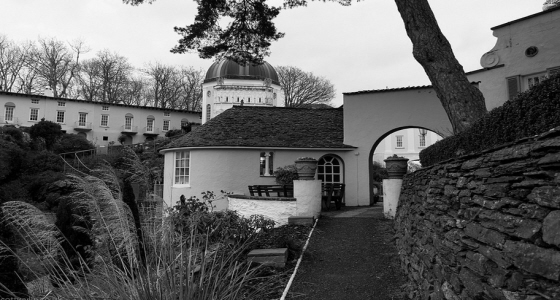
Portmeirion Hotel,
Gwynedd, LL48 6ET, Wales, UK
Phone: 01766-770000
Fax: 01766-771331
Portmeirion Village Official Site
Email: This email address is being protected from spambots. You need JavaScript enabled to view it.
Photographs by generous permission of Robin Llywelyn





